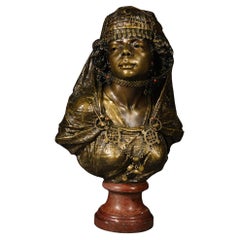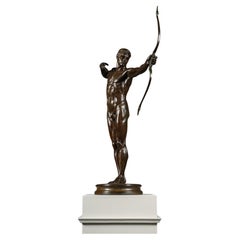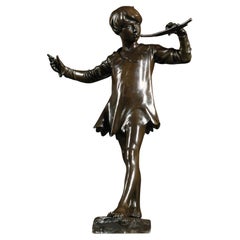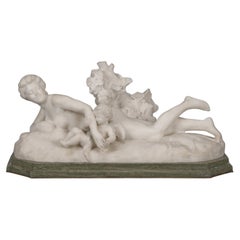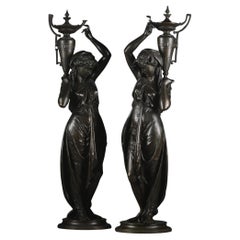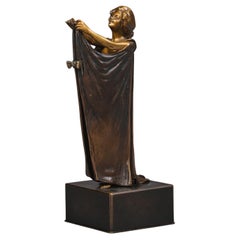Adrian Alan Sculptures
to
1
48
39
9
9
2
1
3
2
2
1
1
40
39
12
9
3
48
46
33
6
3
3
Height
to
Width
to
48
48
48
3
3
2
2
2
Émile Guillemin, A Fine Orientalist Bust of a Young Woman
By Émile Guillemin
Located in Brighton, West Sussex
Émile-Coriolan-Hippolyte Guillemin (French, 1841-1907)
A Fine Multipatinated Bronze Orientalist Bust of A Young Woman.
Signed and dated 'Ele. ...
Category
Antique 19th Century French Busts
Materials
Bronze
A Patinated Bronze Statue Of Teucer, By Sir William Hamo Thornycroft
By William Hamo Thornycroft
Located in Brighton, West Sussex
Sir William Hamo Thornycroft (British, 1850-1925)
A Patinated Bronze Statue Of Teucer
The standing figure of the male nude holding his bow in his outstretched left hand, raised on a...
Category
Antique 19th Century English Neoclassical Figurative Sculptures
Materials
Bronze
A Patinated Bronze Figure Of 'Peter Pan', By Sir George James Frampton
Located in Brighton, West Sussex
Sir George James Frampton (British, 1860-1928)
A Patinated Bronze Statue Of Peter Pan
Depicted playing the pipes and conducting with his right hand. Standing on a naturalistically cast base.
Signed 'G F' in a monogram and 'P P' in a roundel. Dated 1913.
England, Dated 1913.
Provenance:
Gerald Rufus Isaacs, 2nd Marquess of Reading (1889 –1960) and Eva Violet Mond Isaacs, Second Marchioness of Reading (1895–1973).
Thence by descent until sold in 1996.
The present charming statuette of Peter Pan, dated 1913, is an exceptionally fine and early reduction of the life-size bronze exhibited by Frampton at the Royal Academy in 1911. Barrie unveiled the statue in Kensington Gardens on 30 April 1912, without fanfare and without permission, so that it might appear to children that the fairies had put it in place overnight. He published a notice in The Times newspaper the following day, 1 May: "There is a surprise in store for the children who go to Kensington Gardens to feed the ducks in the Serpentine this morning. Down by the little bay on the south-western side of the tail of the Serpentine they will find a May-day gift by Mr J.M. Barrie, a figure of Peter Pan blowing his pipe on the stump of a tree, with fairies and mice and squirrels all around. It is the work of Sir George Frampton...
Category
Vintage 1910s English Figurative Sculptures
Materials
Bronze
A White Marble Figural Group of Venus and Cupid by Henri Weigele
Located in Brighton, West Sussex
A White Marble Figural Group of Venus and Cupid by Henri Weigele.
Signed ‘H. Weigele’ and titled ‘IL PASSEPA'
Born in Schierbach, Haut-Rhin, Henri Weigele (1858- 1927) studied sc...
Category
Antique 19th Century French Figurative Sculptures
Materials
Marble
A Pair Of Napoleon III Patrinated-Bronze Figures by Victor Paillard
By Victor Paillard
Located in Brighton, West Sussex
A Pair Of Napoleon III Patinated-Bronze Figures, Modelled As Classically Robed Maidens Bearing Urns, by Victor Paillard.
The models attributed to Albert-Ernest Carrier-Belleuse (French, 1824-1887).
Each with oval stamp 'VOR PAILLARD / FANTS DES BRONZE / A PARIS'
France, Circa 1865
Victor Paillard (French, 1805-1886)
Paillard first exhibited his work at the Exposition des produits de l'industrie in 1839. He had been experimenting with gilt and silvered bronze since...
Category
Antique 19th Century French Napoleon III Figurative Sculptures
Materials
Bronze
‘Open Sesame’ - A Bronze Concealed Erotic Figure by Carl Kauba
By Carl Kauba
Located in Brighton, West Sussex
‘Open Sesame’ A Finely Cast Gilt and Patinated Bronze Concealed Erotic Figure Of A Young Woman in A Cloak, by Carl Kauba.
This rare gilt and patinated bronze by Carl Kauba is finel...
Category
Antique 19th Century Austrian Art Deco Figurative Sculptures
Materials
Bronze
'La Nature se dévoilant devant la Science' by Louis-Ernest Barrias
By Louis Ernest Barrias
Located in Brighton, West Sussex
A Bronze Figure of 'La Nature se dévoilant devant la Science' by Louis-Ernest Barrias.
Inscribed 'E. Barrias' and with Susse Frères foundry cachet and further Susse inscription.
S...
Category
Antique Early 1900s Figurative Sculptures
Materials
Bronze
'The Warwick Cup', A Victorian Silver Racing Trophy by Elkington
By Elkington & Co.
Located in Brighton, West Sussex
The Warwick Cup
An Important Victorian Silver Presentation Horse Racing Trophy For The 1853 Warwick Races, by Elkington & Co. England. Modelled by Pierre-Emile Jeannest (French, 18...
Category
Antique 19th Century English Victorian Figurative Sculptures
Materials
Marble, Silver
An Exhibition Lifesize Statuary Marble Figural Group
Located in Brighton, West Sussex
An Important Lifesize Statuary Marble Figural Group of a Mother and Her Two Children, Entitled 'Mamma ce n'è una sola' (You only have one mother), By Silverio Martinoli (Italain, 183...
Category
Antique 19th Century Italian Victorian Figurative Sculptures
Materials
Carrara Marble
A Fine And Large Patinated Bronze Figure Of A Sea Nymph
By Luca Madrassi
Located in Brighton, West Sussex
Luca Madrassi (Italian, 1848–1916)
A Fine And Large Patinated Bronze Figure Of A Sea Nymph, Entitled ‘La Fée Des Mers’ (The Spirit Of The Seas)
The semi clad winged nymph, holding a...
Category
Antique 19th Century Italian Figurative Sculptures
Materials
Bronze
A Fine Carved Alabaster Group of The Birth of Venus, On Pedestal
Located in Brighton, West Sussex
A Fine Carved Alabaster Group of The Birth of Venus, On Pedestal.
Modelled with Venus standing in an open oyster shell holding the hand of a nymph seated at her feet. On a veined alabaster pedestal.
Italy, Circa 1900.
The Birth of Venus depicts the moment described by the Roman poet Ovid when, having emerged from the sea in a shell, Venus lands at Paphos in Cyprus. Venus, or Aphrodite in Greek mythology, wears a pearl neckless...
Category
Antique 19th Century Figurative Sculptures
Materials
Alabaster
'La Nature se dévoilant devant la Science' by Louis-Ernest Barrias
By Louis Ernest Barrias
Located in Brighton, West Sussex
'La Nature se dévoilant devant la Science', A Large and Rare Gilt and Silvered Bronze and Marble Figure entitled ('Nature unveiling itself before science') By Louis-Ernest Barrias (...
Category
Antique 19th Century French Belle Époque Figurative Sculptures
Materials
Carrara Marble, Bronze
Patinated Bronze Allegorical Busts of Autumn and Summer By Pierre-Louis Détrier
By Pierre-Louis Detrier 1
Located in Brighton, West Sussex
A Fine Pair of Patinated Bronze Allegorical Busts of Autumn and Summer By Pierre-Louis Détrier.
Finely modelled and cast, the busts depict young maidens allegorical of Summer and Au...
Category
Antique 19th Century French Busts
Materials
Granite, Bronze, Ormolu
Large Multi-Patinated Bronze Figure of an Arab Warrior by Henri-Honoré Plé
By Henri Honoré Plé
Located in Brighton, West Sussex
A Large and Important Multi-Patinated Bronze Figure of an Arab Warrior by Henri Honoré Plé.
Signed Henri Plé to the base.
The figure is finely modelled as an Arab warrior, with sw...
Category
Antique 19th Century French Figurative Sculptures
Materials
Bronze
Pair of Bronze Figures by Etienne-Henri Dumaige
By Etienne-Henri Dumaige
Located in Brighton, West Sussex
A Fine Pair of Bronze Figures Entitled 'Avant le Combat' and 'Apres le Combat', Cast from the models by Etienne-Henri Dumaige (1830 - 1888).
Signed H. Dumaige, with title plaquet...
Category
Antique 19th Century French Figurative Sculptures
Materials
Bronze
Pair of Patinated Bronze Egyptian Figures by Emile Louis Picault
By Émile Louis Picault
Located in Brighton, West Sussex
A Pair of Patinated Bronze Figures Of The Egyptian High Priest 'Pastophore' and The Egyptian Scribe 'Hierogrammate' By Emile Louis Picault (French, 1833-1915).
Each signed 'Picau...
Category
Antique 19th Century French Egyptian Revival Figurative Sculptures
Materials
Bronze
'L'Amour Vainqueur' ('A Love Vanquished') By Adolphe Itasse (French, 1830 - 1893
By Adolphe Itasse
Located in Brighton, West Sussex
A Fine Patinated Bronze Figural Group of Cupid and Psyche, Entitled 'L'Amour Vainqueur' ('A Love Vanquished') By Adolphe Itasse (French, 1830 - 1893).
On a revolving rouge de Fran...
Category
Antique 19th Century French Figurative Sculptures
Materials
Marble, Bronze
Antoine Louis Barye (1795-1875), ' Theseus fighting the centaur Bianor'
By Antoine-Louis Barye
Located in Brighton, West Sussex
A Fine Patinated Bronze Group, Entitled 'Thesée Combattant le Centaure Bianor' ('Theseus Fighting the Centaur Bianor'), Cast by Ferdinand Barbedienne, From the Model By Antoine Louis...
Category
Antique 19th Century French Classical Greek Figurative Sculptures
Materials
Bronze
Emperor Napoleon on Horseback, Cast by Susse Frères, Paris
By Susse Freres
Located in Brighton, West Sussex
A Large Patinated Bronze Sculpture of Emperor Napoleon on Horseback, Cast by Susse Frères, Paris, From the Model By Alfred Émilien O'Hara, Comte de Nieuwerkerke (1811-1892).
Dark br...
Category
Antique 19th Century French Napoleon III Figurative Sculptures
Materials
Bronze
An Orientalist Lifesize Figural Bronze Statue, Attributed to Louis Hottot
By Louis Hottot
Located in Brighton, West Sussex
An Orientalist Lifesize Figural Bronze Statue, Attributed to Louis Hottot (French, 1834-1906).
Modelled as a lady in Ottoman dress standing beneath an Eastern style pagoda with minaret. Depicting as if answering a call and stepping forward in greeting.
France, Circa 1890.
This impressive figural group is a rare work in bronze attributed to the Orientalist sculptor Louis Hottot whose oeuvre is more readily associated with what was called ‘bronze imitation’, referring to sculpture in white-metal or, as it is known today, spelter. That this large statue is cast from superior and costly bronze is indicative of its rarity and importance. The Orientalist subject relates to paintings by Jean-Léon Gérôme (1824–1904), Ludwig Deutsch (1855–1935) Gustav Bauernfeind...
Category
Antique 19th Century French Figurative Sculptures
Materials
Bronze
A White Marble Figure of a Kneeling Cherub, By Pio Fedi
Located in Brighton, West Sussex
A Fine White Marble Figure of a Kneeling Cherub, By Pio Fedi.
Signed to the base 'Pio Fedi Faceva'.
Italian, Circa 1860.
Pio Fedi (1815-1892) was an Italia...
Category
Antique 19th Century Italian Figurative Sculptures
Materials
Marble
Pair of Oval Bronze Reliefs After Clodion
By Claude Michel Clodion
Located in Brighton, West Sussex
A Pair of Oval Bronze Reliefs After Clodion.
Each inscribed to the cast Clodion.
Each plaque depicts a Bacchic scene of a maiden dancing with a young s...
Category
Antique 19th Century French Louis XV Figurative Sculptures
Materials
Bronze
‘Diana the Huntress’. A Near Lifesize Statuary Marble Group
By Alfred Boucher
Located in Brighton, West Sussex
Alfred Boucher (French, 1850-1934), ‘Diana the Huntress’, A Near Lifesize Statuary Marble Group.
Modelled nude with head turned looking to her left, striding forward holding the greyhound by its collar with her right hand and a giltwood bow in her left hand. On an integral carved base with foliage support.
Signed 'A. BOUCHER'
Boucher’s choice of pose is deliberately indebted to the celebrated mid-16th century painting of Diana the Huntress by an anonymous artist of the School of Fontainebleau. The painting is a mythical representation of Diane de Poitiers, the mistress of King Henry II, in the guise of the goddess Diana, who is shown nude, walking forward beside a greyhound, looking over her left shoulder and holding a bow. Another clear antecedent for Boucher’s ‘Diane the Huntress...
Category
Antique 19th Century French Neoclassical Revival Figurative Sculptures
Materials
Carrara Marble
‘The Monkey Rider’, Paul Joseph Raymond Gayrard
Located in Brighton, West Sussex
‘The Monkey Rider’ – Paul Joseph Raymond Gayrard (1807 - 1855).
Signed to the base ‘Paul Gayrard’ and dated 1846.
A rare patinated bronze group of a monkey in the guise of a Jockey riding a racehorse, startled by a barking dog at his feet.
French, Dated 1846.
The mid-nineteenth century saw a surge of interest in animalier bronzes with whimsical and anthropomorphic subjects becoming particularly fashionable. In a similar vain to Christophe Fratin’s humanised depiction's of Bears posed as lamp lighters, dentists and reading books, Gayrard created his famous Monkey bronzes. He was awarded a First Class Medal at the 1846 Salon for his humorous group ‘The Monkey Steeplechase’, which can be related to subject of the present sculpture, ‘Monkey Rider’.
With the publication of Darwin’s ‘Origin of Species in 1859’ the popularity of anthropomorphically conceived subjects began to decline. As such these sculptures were only created during a very brief window of time and are consequently very rare.
PAul Joseph Ryamond Gayrard
Paul Joseph Raymond Gayrard (1807 – 1855) born in Clermont-Ferrand, France.
He studied at an early age under his father the sculptor and engraver Raymond Gayrard, before becoming a student of François Rude and later David d'Angers.
He first exhibited at the Paris Salon in 1827 and continued to submit works throughout his lifetime winning a Second Class Medal in 1834 and a First Class Medal in 1846 and 1848. His last recorded exhibit was in 1855.
He executed many busts of notables of the day which proved popular with the haute bourgeois, but it was his talent for animalier that confirmed his reputation as a sculptor of considerable talent. His known bronze animal models date from the years 1846 until 1848 with his powerful plaster of a 'Harness Horse...
Category
Antique Mid-19th Century French Animal Sculptures
Materials
Bronze
Antoine Louis Barye, Bronze Model of 'Elephant De Senegal'
By Antoine-Louis Barye, Ferdinand Barbedienne
Located in Brighton, West Sussex
Antoine-Louis Barye (French, 1795-1875).
‘Éléphant du Sénégal’ (‘Senegalese Elephant’).
Patinated bronze.
Cast by Ferdinand Barbedienne, Paris, from the model by Antoine-Louis B...
Category
Antique 19th Century French Animal Sculptures
Materials
Bronze
‘Le Grand Jockey ‘I by Sidore Jules Bonheur
By Isidore Jules Bonheur
Located in Brighton, West Sussex
Isidore Jules Bonheur (French, 1827-1901)
‘Le Grand Jockey ‘
Signed 'I Bonheur' and with foundry stamp PEYROL EDITEUR'.
Bronze, rich mid-brown pa...
Category
Antique 19th Century French Animal Sculptures
Materials
Bronze
Important Set of Four Large Porphyry Obelisks
Located in Brighton, West Sussex
An important set of four large Porphyry Obelisks.
Each obelisk is of square section tapering form with a spiked orb finial and embellished with carved roundels of the twelve Roman Emperors in profile. The main body is raised on ball supports putdown on square sectioned plinth bases.
Each obelisk is carved with three Emperors profile...
Category
Antique 19th Century Italian Neoclassical Pedestals and Columns
Materials
Porphyry
Art Deco Statuary Marble Figure of Cleopatra
Located in Brighton, West Sussex
An Art Deco statuary marble figure of Cleopatra.
The half-lifesize standing figure posed with her right foot raised and looking to dexta, in front of a recumbent sphinx raised on a stepped entablature. On a Siena marble pedestal carved with panelled front.
Italian, Early 20th century.
Intertwining history and legend, the story of Cleopatra (68-30 B.C.) has inspired artists for centuries. The present depiction dates to a period of Egyptomania inspired by Howard Carter...
Category
Early 20th Century Italian Art Deco Figurative Sculptures
Materials
Marble
$38,375 Sale Price
25% Off
'Cupid & Psyche' an Important Bronze Figure by François-Raoul Larche
By François-Raoul Larche
Located in Brighton, West Sussex
'Cupid & Psyche' - An important parcel-gilt and patinated bronze figure, by François-Raoul Larche.
Signed to the base 'Raoul Larche 1891'.
This finely cast parcel-gilt bronze figure depicts Cupid and Psyche with Zephyr.
François-Raoul Larche (1860-1912), the son of an ornamental sculptor, was a well-known Art Nouveau sculptor...
Category
Antique 19th Century French Figurative Sculptures
Materials
Bronze
River Nymphs, After Jean Goujon
By Jean Goujon
Located in Brighton, West Sussex
A fine pair of patinated bronze figures of River Nymphs, After Jean Goujon.
These charming figures are inspired by the nymphs on the monumental ‘Fontai...
Category
Antique 19th Century French Figurative Sculptures
Materials
Bronze
Pair of Patinated Bronze Busts
Located in Brighton, West Sussex
A pair of patinated bronze busts.
French, circa 1870.
Category
Antique 1870s French Busts
Materials
Bronze
Bronze Figure of 'La Nature Se Dévoilant Devant La Science'
By Louis Ernest Barrias
Located in Brighton, West Sussex
Bronze figure of 'La Nature se dévoilant devant la Science' by Louis-Ernest Barrias.
Inscribed 'E. Barrias' and with Susse Frères foundry cachet and further Susse inscription.
Thi...
Category
Early 20th Century French Figurative Sculptures
Materials
Bronze
'The Temptation' by Eugene-Victor Cherrier
By Eugène-Victor Cherrier
Located in Brighton, West Sussex
'The Temptation' by Eugene-Victor Cherrier.
A fine patinated bronze ewer modeled in high relief depicting Adam and Eve in the Garden of Eden.
Sig...
Category
Antique Early 1900s French Art Nouveau Figurative Sculptures
Materials
Bronze
'Le Puits Qui Parle' an Exhibition Bronze, Paul Eugène Mengin French, circa 1900
By Paul Eugène Mengin 1, Susse Freres
Located in Brighton, West Sussex
'Le Puits Qui Parle' (The Speaking Well) - An Important Exhibition Bronze Group, by Paul Eugène Mengin.
Signed to the cast 'P MENGIN', and inscri...
Category
Early 20th Century French Figurative Sculptures
Materials
Bronze
Pair of Restoration Period Gilt-Bronze Allegorical Groups. French, circa 1830
Located in Brighton, West Sussex
An exceptional pair of restoration period gilt-bronze allegorical groups depicting music and wine.
Each group is set on a naturalistically modelled base and finely modelled and ch...
Category
Antique Early 19th Century French Napoleon III Figurative Sculptures
Materials
Bronze
Pair of Restoration Period Gilt-Bronze Figural Groups. French, circa 1830
Located in Brighton, West Sussex
An exceptional pair of restoration period gilt-bronze figural groups, allegorical of hunting and fishing.
Each group is set on a naturalistically modelled base and finely modelled...
Category
Antique Early 19th Century French Napoleon III Figurative Sculptures
Materials
Bronze
'Bacchantes', a Fine Patinated Bronze Figural Group After Clodion, circa 1870
By Claude Michel Clodion
Located in Brighton, West Sussex
'Bacchantes', a fine patinated bronze figural group after Claude Michael Clodion, French (1738-1814).
French, circa 1870.
Signed 'Clodion' to the base and inscribed 'BACCHANTE...
Category
Antique Late 19th Century French Figurative Sculptures
Materials
Bronze
François Truphème (1820 -1880) - 'Moses and Jochebed'
By François Truphème, Thiebaut Freres
Located in Brighton, West Sussex
'Moses and Jochebed - A Fine Patinated Bronze Figural Group After A Model by 'François Truphème', Cast by 'Thiebaut Frères'.
Signed 'Fois Truphème 1863' and 'fdu par Vor Thiebaut'....
Category
Antique Mid-19th Century French Figurative Sculptures
Materials
Bronze
‘Mosè Salvato Dalle Acque’. An Important Marble Group By Pietro Bazzanti
By Pietro Bazzanti
Located in Brighton, West Sussex
Pietro Bazzanti (Italian, 1825-1895) - ‘Mosè Salvato Dalle Acque’.
An Important Exhibition Florentine Marble Group of Moses Rescued from the Waters, on a carved Rosso Levanto Pedest...
Category
Antique Late 19th Century Italian Figurative Sculptures
Materials
Marble
'The Juggler', an Art Deco Bronze Figure, by Claire J. R. Colinet, circa 1925
By Claire Jeanne Roberte Colinet
Located in Brighton, West Sussex
'The Juggler' - A fine Art Deco silvered bronze figure, by Claire J. R. Colinet.
French, circa 1925.
Engraved to base 'CL J.R. Colinet'.
This dramatic and large silvered b...
Category
Early 20th Century French Art Deco Figurative Sculptures
Materials
Bronze
Patinated Bronze Figure of a Native American Scout by Carl Kauba, circa 1910
By Carl Kauba
Located in Brighton, West Sussex
A fine patinated bronze figure of a Native American scout by Carl Kauba.
Austrian, circa 1910.
Signed in the cast 'Carl Kauba'.
The figure cast as an American Native scou...
Category
Early 20th Century Austrian Figurative Sculptures
Materials
Bronze
Bronze Figure of a Native American Scout with Rifle by Carl Kauba, circa 1910
By Carl Kauba
Located in Brighton, West Sussex
A fine patinated bronze figure of a Native American scout with rifle, by Carl Kauba.
Austrian, circa 1910.
Signed in the cast 'Carl Kauba'.
The figure cast as an American...
Category
Early 20th Century Austrian Figurative Sculptures
Materials
Bronze
Bronze Putto Figure Emblematic of Architecture, after Clodion, circa 1890
By Claude Michel Clodion
Located in Brighton, West Sussex
A fine patinated bronze Putto figure emblematic of architecture, after Claude Michel Clodion.
French, circa 1890.
Standing at 55 cm (22 inches) tal...
Category
Antique Late 19th Century French Figurative Sculptures
Materials
Bronze
'L'innocence Tourmentée Par L'amour' A Figural Group by Luca Madrassi circa 1900
By Luca Madrassi
Located in Brighton, West Sussex
'L'innocence Tourmentée Par L'amour' - A fine patinated bronze figural group by Luca Madrassi.
French, circa 1900.
Inscribed 'L.MADRASSI.PARIS'.
With Gervais foundry cachet...
Category
Antique Late 19th Century French Belle Époque Figurative Sculptures
Materials
Bronze
Multipatinated Bronze Orientalist Female Bust by Henri Honoré Plé, Dated 1883
By Henri Honoré Plé
Located in Brighton, West Sussex
An important multi patinated bronze orientalist female bust by Henri Honoré Plé.
French, dated 1883.
Engraved to the back 'Henri Plé / 1883'.
...
Category
Antique Late 19th Century French Busts
Materials
Bronze
'Bonne Année, Bonne Santé', a Bronze Figure by Adolphe Maubach, circa 1900
By Adolph Maubach
Located in Brighton, West Sussex
'Bonne Année, Bonne Santé' -A fine patinated bronze figure by Adolphe Maubach.
French, circa 1900.
Signed 'Adolphe Maurbach' and bearing a gilt-bronze title plaque 'Bonne Anné...
Category
Antique Late 19th Century French Figurative Sculptures
Materials
Bronze
'Grand Nu Aux Feuillages', a Fine Patinated Bronzed Figural Group, circa 1900
By Alois Mayer
Located in Brighton, West Sussex
'Grand Nu Aux Feuillages', a fine patinated bronzed figural group by Alois Mayer.
German, circa 1900.
Signed 'A. Mayer'.
Alois Mayer (1855-1936) Was a German Sculptor who...
Category
Antique Late 19th Century German Figurative Sculptures
Materials
Bronze, Iron
Pair of Bronze Models of a Standing Bull and a Running Cow, circa 1890
By Isidore Jules Bonheur, Francois Auguste Hippolyte Peyrol 1
Located in Brighton, West Sussex
A pair of large and finely patinated bronze models of a standing bull and a running cow after models by Isidor-Jules Bonheur, Cast on a Naturalistic Base.
French, circa 1890.
Signed 'I BONHEUR' and stamped 'PEYROL EDITEUR'.
Bonheur was a regular exhibitor at the Paris Salon and his naturalistic depiction of farm animals, including cattle, was one of his most popular subjects. The bronze was cast by his brother-in-law, Hippolyte Peyrol, who ran one of the most successful art foundries in Paris at this time.
Isidore-Jules Bonheur (1827-1901) was the son of the painter Raymond Bonheur and younger brother of Rosa Bonheur, the famous sculptor. He was born in Bordeaux and studied painting, at first with his father and then with the Ecole des Beaux Arts in Paris, moving on to sculpture in 1848.
He made his debut at the Paris Salon in 1848 with a painting and plaster study of the same subject ‘African horseman attacked by a lioness’. From then onwards, Bonheur exhibited regularly at the Salon as well as other exhibitions, winning medals in 1865 and 1869 together with the prized Gold Medal at the Exposition Universelle of 1889.
He was awarded the Legion d’Honneur in 1895.
Most of Bonheur’s casts were by his uncle by marriage, Hippolyte Peyrol, whose tiny foundry mark is often very difficult to find.
Bonheur’s studies range from farm animals, bears and tigers in a very naturalistic vein to equestrian groups. Although noted primarily for his small groups he did complete two large scale commissions, one to his sister Rosa, at Fontainbleau and the other, two stone lions at the steps of the Royal...
Category
Antique Late 19th Century French Animal Sculptures
Materials
Bronze
